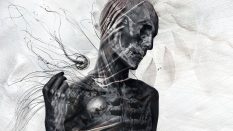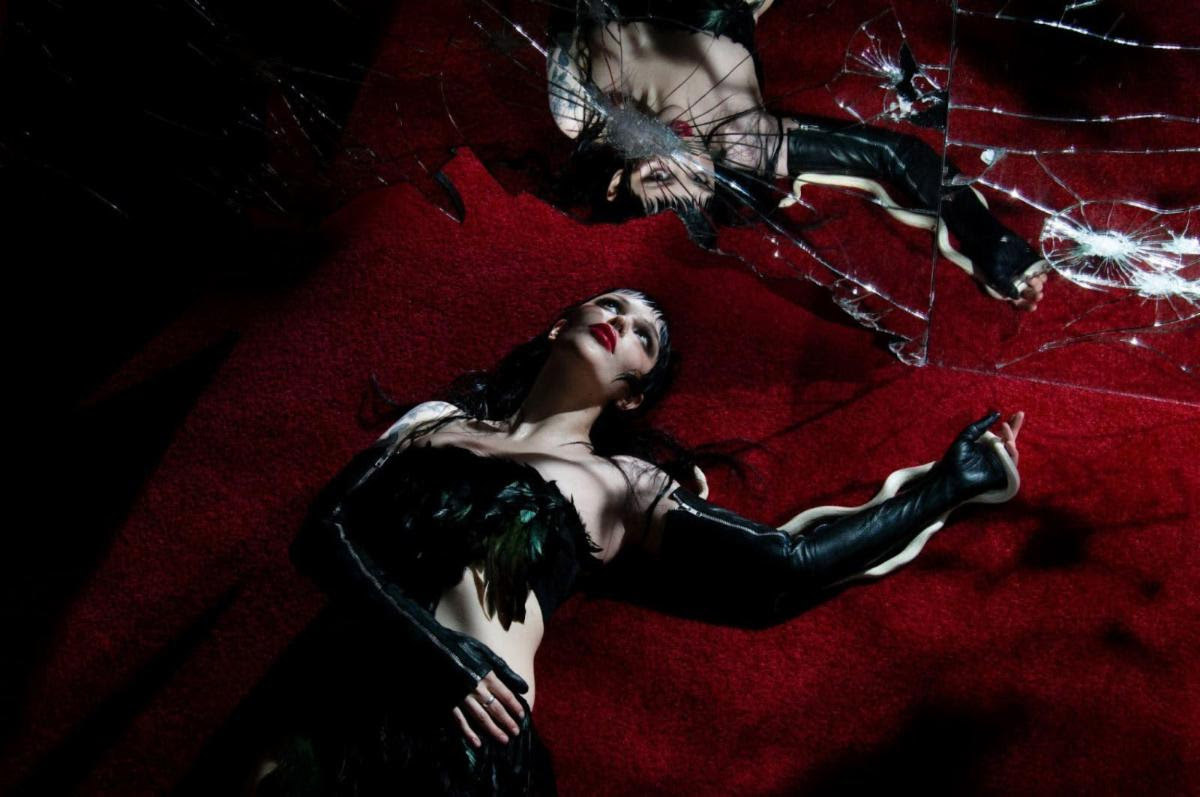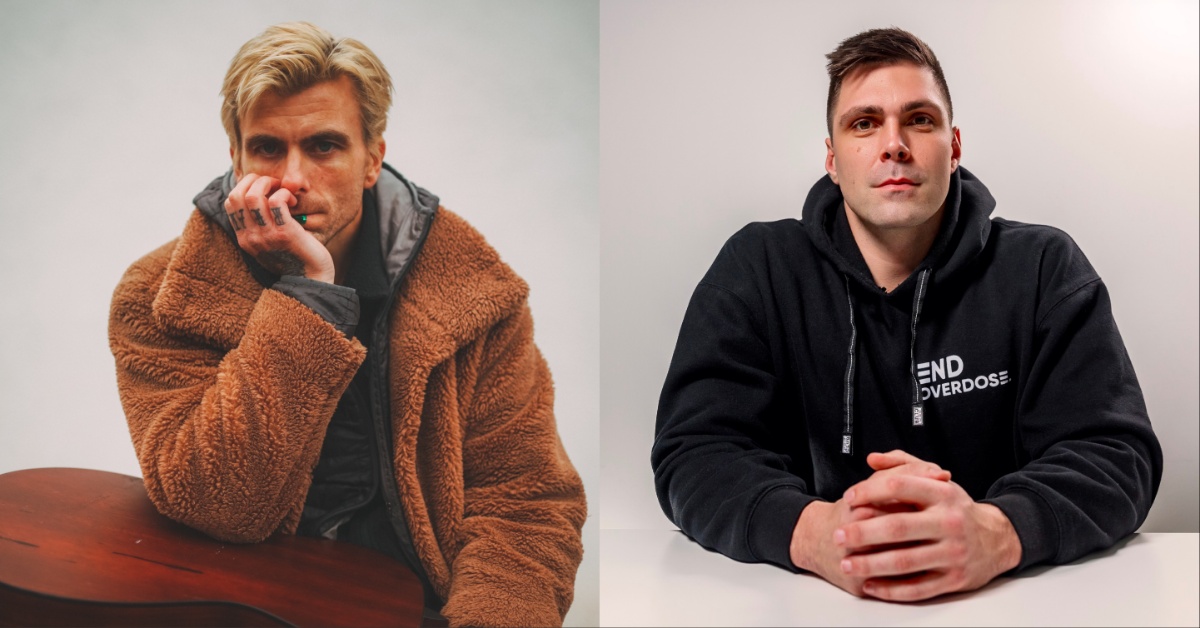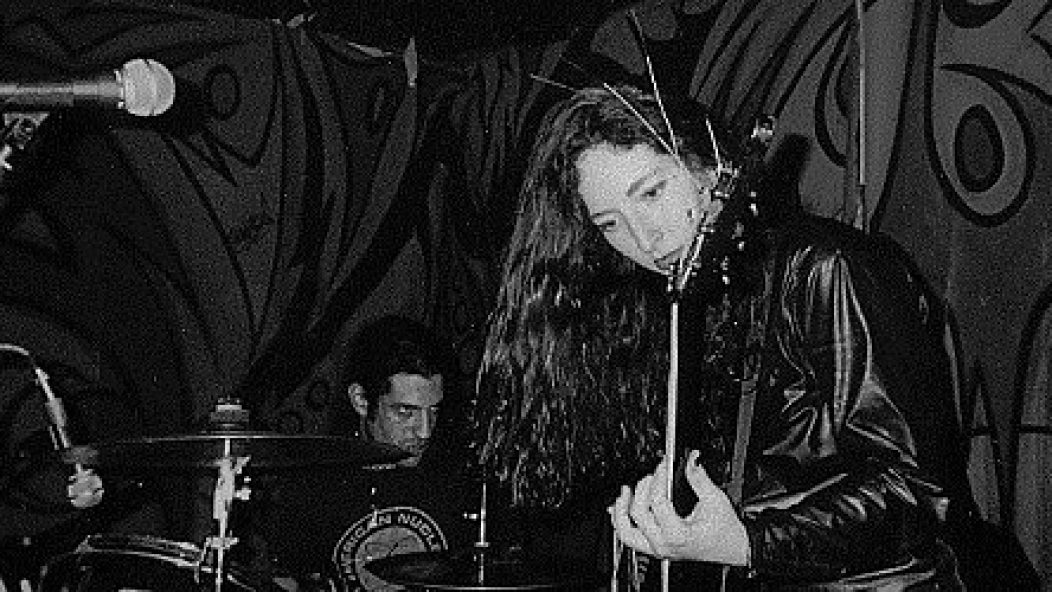
The Story of Lucifer's Hammer: Part 2
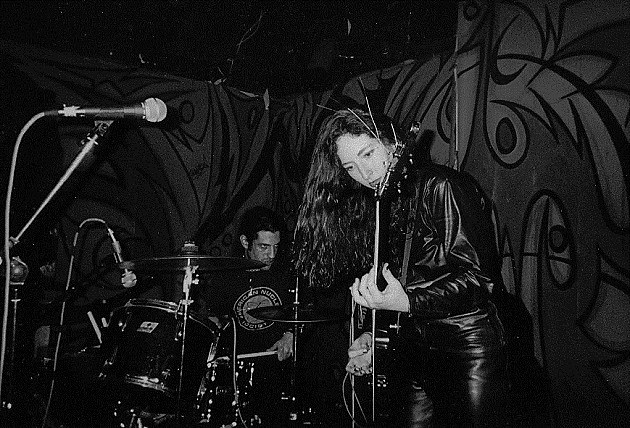
…
In this three-part series, Avinash Mittur tracks the resurgence of the Bay Area metal scene through the reflections of the people who saved it. In Part 1, he spoke with Slough Feg’s Mike Scalzi over the phone, chatted with Ross Sewage at a fest, and met John Cobbett (Hammers of Misfortune, Slough Feg, Ludicra, Vhöl), Aesop Dekker (Ludicra, Agalloch, Vhöl, Worm Ouroboros), and Matt Shapiro at a coffee shop for beers. Part 2 picks up with punk petering out, leaving a live show hole for metal to fill.
…
In order to see the music they loved played onstage, John Cobbett would throw together punk/crust/metal crossover shows. Before long, the idea of a local “metal club” became very real. It would be called Lucifer’s Hammer, a weekly gathering where unique metal bands would take the stage, the newest and coolest albums would play over the PA, and fellow headbangers could gather to chat about metal over a few beers. Aesop Dekker, who already had years of experience with bars, clubs, and DIY shows, would prove to be a perfect co-conspirator. His strategy was one that worked for him even before moving to San Francisco: take over the worst night at the local dive.
“We did this in Miami with this shitty bar that had a stage,” Dekker explains. “We were just like, ‘What’s your shittiest night?’ [It would be] Monday or Tuesday.” Cobbett interjects: “That’s why there’s always ‘Metal Mondays,’ it’s the shittiest night in the bar business.” Dekker adds, “No one’s coming in. It was like if they had four people coming, how about I promise them seven? It’s like, you could do that; it was low risk for the bar to give you the shittiest night of the week.”
The Covered Wagon Saloon was the bar welcoming Lucifer’s Hammer. For a few years, Tuesday night at the Covered Wagon was where Bay Area headbangers could gather and listen to the raddest metal around. By squeezing the remaining momentum out of the dying Mission punk scene, Cobbett kept his metal club alive.
“It was clear to me that there was a lot of energy in this [punk] scene that kind of had nowhere to go,” Cobbett remembers. “It was also clear to me that there was a groundswell of bands like Old Grandad popping up. I looked around and found out that there were metal bands in San Jose like Exhumed and Impaled, bands like Missile Command from Sacramento, and I started doing shows where I’d mix those bands in with like crustcore bands, noise bands, a lot of powerviolence, just because I’d want to do a show and there weren’t a lot of straight up metal bands to do an entire metal bill. So I’d mix things up. Our motto was ‘All Metal, All the Time.’ We couldn’t book all metal all the time though! There just wasn’t much metal around.” As Cobbett finishes his sentence, Matt Shapiro turns to him and brings up the doubt he felt all those years ago. “I remember you came to the Chameleon one night and said you were going to start a weekly metal night. I was impressed but I was also like, ‘No way, you’ll run out of bands after two weeks!’”
Not only were there not enough bands to fill out an all-metal bill every week, but Cobbett needed the remaining Mission punk fans to fill the bar he had now taken over.
…
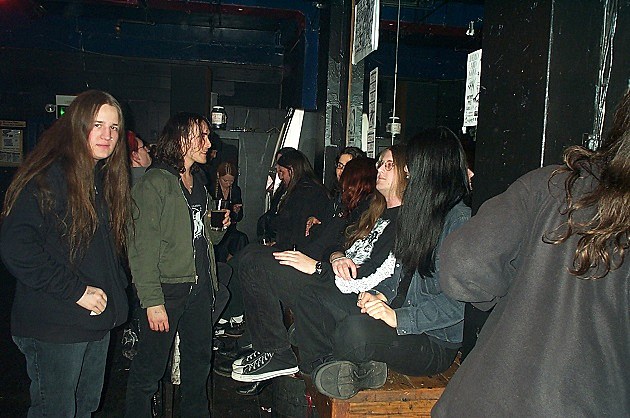
…
At the time, Mike Scalzi was not pleased with the arrangement. “[Cobbett] presented it to me almost like a business plan. He’s like, ‘I’m starting a metal scene, but we have to have hardcore bands.’ We even argued about it at one point a little bit the first year we met,” Scalzi recalls over the phone. “He was like, ‘Look, you have to play with these bands. You have to put up with them. We have to have hardcore bands, we have to have shitty crust bands, we have to have bands that play metal but kind of sound more like hardcore. This is not the kind of metal that you play or that I want to play, but we have to incorporate this if we want to do our stuff. It’s only going to help us facilitate the crowd for it.’ Of course, I was the guy being more blunt-minded and stubborn about that kind of thing. ‘No fuck that, metal up your ass! I don’t like these bands, I’m not gonna lie and say I like this kind of bullshit.’ I was playing music for 10 years by then, I refused to pretend to be into that stuff. But he was like, ‘We have to,’ and he was right.”
“The thing is, all of us had an affinity for metal. But there wasn’t metal around!” Dekker says. “This is an important point,” Cobbett acknowledges. “Nobody would play metal. Metal was so stigmatized that the only way to play metal in this town was to do it as a joke. The minute it became clear to me there were people willing to play metal in San Francisco, I was in five bands. But before that, the only way I could get people together to play metal was to do it in this sort of ironic Melvins/noise sort of capacity.”
Even though the old Mission punk scene was waning, the values lived on, and bands failing to break the mold were quickly forgotten. “We were all punk rockers, and [the club] was formed with a DIY spirit and a more of an artistic sort of spirit,” Cobbett says. Dekker concurs: “I think one of the things that’s really magical about the San Francisco scene was. . .you know that whole stupid thing of like, ‘Support actual metal!’ It’s like, how about support good music? How about support bands that are good and are doing something interesting regardless of the genre, and not worry about what’s metal and what’s not metal? That’s kind of like what we did back in the day with Hickey and setting up these shows. It was like, ‘Holy shit, Old Grandad is awesome.’ I don’t remember getting guff. No one was like, ‘These guys are metal and they suck.’”
While the first two years of Lucifer’s Hammer at the Covered Wagon were slow going, the timing would prove to be pivotal for the growing community of fans and musicians, one of whom was a nineteen year-old Leon del Muerte.
…
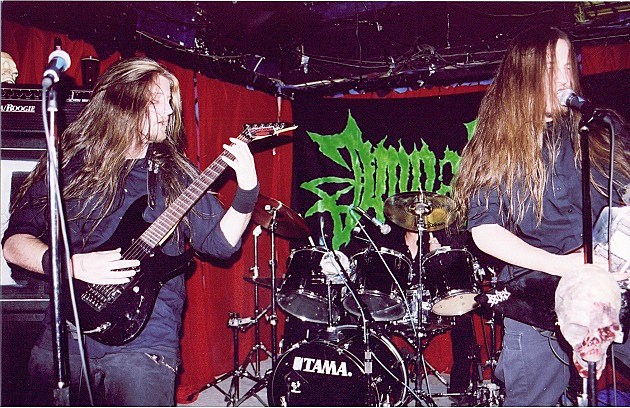
…
Del Muerte and I chat at a bar near his present residence in Echo Park, Los Angeles. He is hours away from playing a show with his current band, the reactivated grind pioneers Nausea. In 1998, however, del Muerte was a guitarist and vocalist for Oakland’s death metal goofballs Impaled, who ended up becoming a regular attraction at Lucifer’s Hammer.
“For a long time, Impaled was kind of the house band at the Covered Wagon,” del Muerte remembers. “We weren’t touring then and we didn’t know any better to just say no to shows. Whenever a band dropped off or whenever [Cobbett] needed somebody to play, we just drove across the bridge and played.”
Impaled would even accept shows with bands as odd as the Melvins. “It was a secret show, they didn’t play under the name ‘The Melvins,’ del Muerte explains. “We had to play after them. When they were playing, it was packed. Like people were at the window peering in. As soon as they were done, everybody split and we were supposed to play.”
Thanks to selective incorporation of quality crust, noise, and hardcore bands into the weekly shows, attendance at the Covered Wagon was high enough to keep Tuesday nights reserved for Lucifer’s Hammer. According to Cobbett and Dekker’s plan, the Covered Wagon became the place where the Mission’s old punks and crusties could support metal bands they found interesting. Subsequently, the hybrid crowd of headbangers and punks ended up forming the core of this new community.
“I remember a lot of those shows outside of San Francisco, the crusties and metal guys wouldn’t mix as much,” del Muerte says. “I remember it was like half my friends in San Francisco. We were just a straight death metal band and it would be half crusties there.”
The crowd ultimately wouldn’t care about death metal versus crust. If the bands were interesting and cool, the fans would come out and support them. This would prove to be a defining feature of the first year of Lucifer’s Hammer: the bands wouldn’t sound alike, but they would all have something special and unique to offer. Genre (and later on, sub-genre) didn’t matter. Quality mattered.
It took about six months’ worth of weekly shows with odd lineups but by the end of 1998, Cobbett and Dekker could finally put together a few concerts that really were “All Metal, All the Time.” Halloween 1998 would be the point of no return, when a show made up of nothing but metal bands managed to draw people from all over the Bay Area.
“Metalween in 1998 was a big night. Black Goat, Unholy Cadaver, and Weakling, and there was a line down the fucking street for that,” Cobbett recalls. “That was the first time I realized, ‘Oh shit, this could be interesting.’ Everybody went to that, it was huge. I couldn’t believe it! That’s when I realized that there was a subset of people who are so sick of the smarmy-ass indie rock and ironic bullshit, and they want to see something serious. Weakling was fucking serious you know?” Weakling, an early favorite at Lucifer’s Hammer, would write the book on American black metal, influencing Cobbett and Dekker to form their own game-changing black metal band, Ludicra.
Though the local acts would slowly establish themselves as forces to be reckoned with, it would be the touring bands that drew fans from all over the Bay Area. The first international metal act to step foot in the Covered Wagon would be one of the most infamous in the metal genre, Norway’s Mayhem.
…
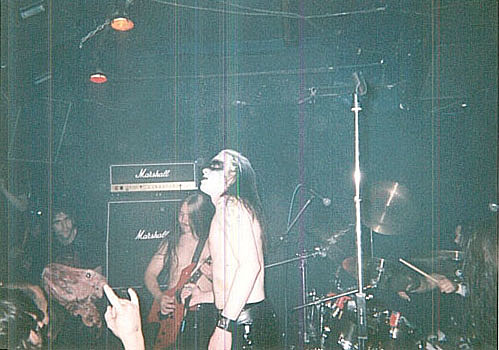
…
“That was an amazing, amazing night,” says Cobbett. “What we’re talking about is a really shitty punk rock dive bar with Mayhem and people came from miles around to see that one, man. I had bands calling me on the phone and getting all fuckin’ Varg Vikernes on me saying, ‘I will kill to play with Mayhem. I will kill to get on that show.’” Cobbett chuckles at the ridiculousness of the situation. “I had to go the butcher and get skinned cow heads and bring them to the show. It was amazing, man.”
Young Leon del Muerte showed up at the Covered Wagon early and hid in the bathroom for hours, hoping to see the black metal legends play the saloon. The attempt, one among many others, was unsuccessful.
Not every touring act would do good business at the Covered Wagon though. “Impaled Nazarene was apparently a little too obscure and I lost like two grand on that show. They’re from Finland, it cost a lot of money to get them over here,” Cobbett remembers. Dekker counters: “That still stands as one of the best live performances I’ve ever seen.”
Still, despite some bumps, Cobbett’s blueprint was set: The touring bands brought fans out, the local bands would make them return. “The following week I had Weakling and Amber Asylum share a bill for Lucifer’s Hammer, just the two of those bands, and that time I made all the money back because it was packed,” Cobbett says. “By that time, Weakling and Amber Asylum were well-regarded in the Bay Area. There was definitely something happening. There was definitely a scene.” Dekker agrees: “The best thing that came out of Lucifer’s Hammer wasn’t that we created bands, it was that it united pre-existing scenes that were very isolated and brought them all together and basically made the Bay Area as a whole a smaller, more integrated place.”
Ludicra, one of the Bay Area’s champions for honest, forward-thinking metal, would be a direct product of that unification. The band was built from three cities: Guitarist John Cobbett, drummer Aesop Dekker, and vocalist Laurie Sue Shanaman were from San Francisco; guitarist Christy Cather from Sacramento; and bassist Ross Sewage from San Jose. [Ed. note: Jesika Christ, of Sangre Amado, was an original Ludicra member with Cobbett, Dekker, and Cather. The four shared the same practice space.]
“It was really divided. Now, well, no one lives in San Francisco anymore, but when Ludicra was in full swing, it felt like there was no longer a San Francisco scene or an Oakland scene. It was a Bay Area scene, it was unified,” Dekker says. “Ludicra played more shows in Oakland than we did at home because there were more venues. Before that, pre-Lucifer’s Hammer, there was a real divide. It was a different city and too much of a hassle to go to a show.” Cobbett concurs: “People from San Jose would drive up to see a metal show because it was that special at the time. People would drive from Sacto man, on a Tuesday night to see a fuckin’ metal show. That’s the lengths people would go to.”
…
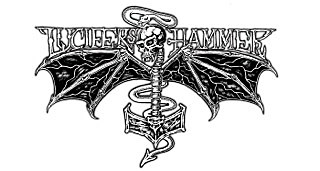
…
In the next installment, Lucifer’s Hammer goes down swinging. Part 3, Tuesday.
…







